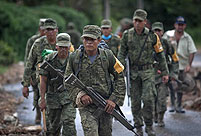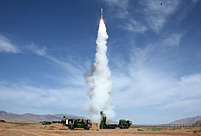Faranak Kamyar has a shop in Tehran selling Moaragh, wood blocks with individual pieces of exotic wood handcrafted together. Her shop receives orders from Europe, the United States and regional Arab neighbors.
"I used to think China was not a good market," Kamyar told Beijing Review. But in 2009 she met Masoud Kamali Ardakani, Commercial Attaché of the Embassy of Iran to China, who encouraged Kamyar to go to China. Since then Kamyar began to attend several industrial exhibitions in Urumqi of Xinjiang Uygur autonomous region, Kunming of Yunnan province, Xining of Qinghai province and Nanchang of Jiangsu province. The most recent exhibition she attended was the China-Arab States Expo held on Sept 15-19 in Yinchuan, Ningxia Hui autonomous region.
"Chinese customers haven't seen similar products before, so they need some time to accept my products," Kamyar said. Prices of her products range from 400-4,000 yuan ($65.35-653.47) per piece. Still, she is making money in China. At a four-day trade exhibition last year in Urumqi, she sold 20,000 yuan ($3,267.34) of her products.
Kamyar's sales may seem modest or even insignificant, but they offer a glimpse into the growing trade between China and the Middle East as well as other Arab states, a region that is actively courting Chinese investment and warming up to Chinese goods.
Active trade
According to statistics by China's Ministry of Commerce (MOFCOM), bilateral trade between China and Arab states reached $222.4 billion in 2012, up by 14 percent year on year, hitting a record high. Of the total, China sold $91.3 billion worth of goods and bought $131.1 billion of goods in return. In the first half of 2013, trade between China and the region continued to grow, reaching $115 billion, up 3 percent year on year. Arab states have become China's sixth largest trade partner.
Northwest China's Ningxia, home to the country's largest Muslim community, plays an important part in China's trade with Arab nations. According to figures from the Department of Commerce of Ningxia Hui autonomous region, the trade volume between Ningxia and Arab nations reached $136.04 million in the first half of the year, 8.48 times the figure in the same period last year.
"In 2012, non-oil trade between China and Arab states in the region reached $119.1 billion, accounting for more than half of the total trade volume," said Yang Fuchang, former vice minister of Foreign Affairs. This shows that bilateral trade cooperation is growing more diversified."
"More Chinese products with high-tech elements are exported to Arab nations. Cars and electronic devices made in China are gradually being accepted and liked by Arab consumers," said Li Xiaobing, deputy director of MOFCOM's Department of Western Asian and African Affairs, at the China-Arab States Expo.
The Gulf Cooperation Council (GCC), established in 1981, is a political and economic union of Arab states bordering the Persian Gulf. Its member states include Bahrain, Kuwait, Oman, Qatar, Saudi Arabia and the United Arab Emirates (UAE). According to Li Jinzao, Vice Minister of Commerce, China-GCC trade reached $155 billion in 2012, accounting for 70 percent of all China-Arab trade. In the first half of this year, GCC countries invested more than $100 million in China, a year-on-year increase of 30 percent.
"The Chinese Government is not only encouraging capable Chinese companies to invest in the infrastructure and manufacturing sectors, but also tout their new technology in building advanced oil and gas storage, transportation facilities and petroleum engineering solutions to the member states of the GCC," said Li.
At the forum, some commerce officials from the GCC countries also expressed their views on bilateral trade between China and Arab states. "By 2015, 55 percent of energy consumed by China will come from the Gulf region, and China will overtake India to become the UAE's largest trading partner, when trade between the two countries will reach $60 billion," said Abdullah Saleh, the UAE's Vice Minister of the Economy. According to Saleh, the free trade agreement between China and the GCC is likely to be signed by both sides between October and December this year and he thinks bilateral trade will get a further boost when more trade agreements are signed in the near future.

 Storms leave 97 dead, 58 missing in Mexico
Storms leave 97 dead, 58 missing in Mexico New model of indigenous surface-to-air missiles testfired
New model of indigenous surface-to-air missiles testfired  118.28-carat diamond to be auctioned in HK
118.28-carat diamond to be auctioned in HK Maternal love under streetlight
Maternal love under streetlight Naked foreign student sits in the middle of a road in Haikou
Naked foreign student sits in the middle of a road in Haikou  Colorful Yunnan: Enjoy the natural beauty
Colorful Yunnan: Enjoy the natural beauty Harbin named Chinese city with most beautiful women
Harbin named Chinese city with most beautiful women For last four students, teacher couple sticks to post on island
For last four students, teacher couple sticks to post on island  When big sport stars were kids
When big sport stars were kids PLA's 38th Group Army conduct training
PLA's 38th Group Army conduct training Residences of the royal house of Savoy
Residences of the royal house of Savoy The last days of Wan Aihua
The last days of Wan Aihua Highlights at 12th National Games of China
Highlights at 12th National Games of China Beijing Film Academy welcomes freshmen
Beijing Film Academy welcomes freshmen Large mahjong party sets new world record
Large mahjong party sets new world recordDay|Week|Month